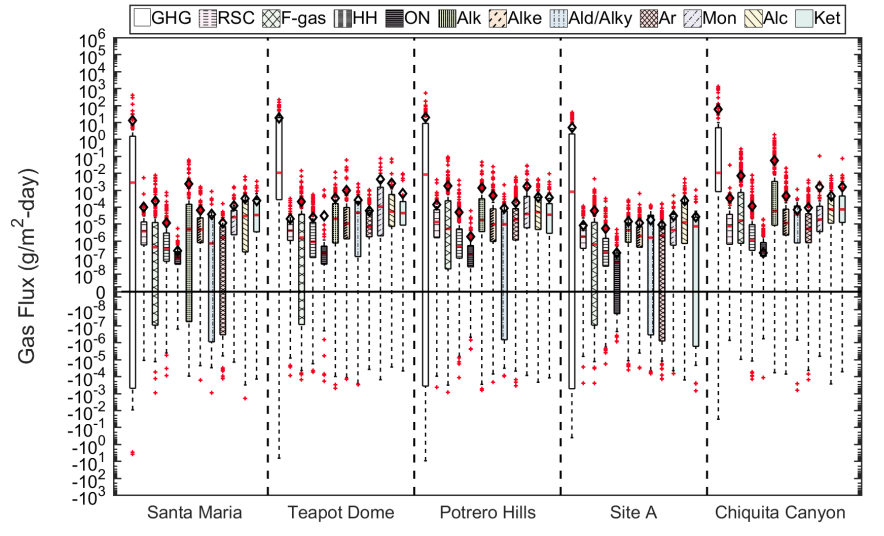Anthropogenic Sources - Landfills Basic

Inter-landfill flux results (Figure 5.1 from the report "Estimation and Comparison of Methane, Nitrous Oxide, and Trace Volatile Organic Compound Emissions and Gas Collection System Efficiencies in California Landfills", Part 5)
Reading Guide
(From the U.S. EPA's "Basic Information about Landfills"):
In the U.S., modern landfills are well-engineered and managed facilities for the disposal of solid waste. Landfills are located, designed, operated and monitored to ensure compliance with federal regulations. They are also designed to protect the environment from contaminants, which may be present in the waste stream. Landfills cannot be built in environmentally-sensitive areas, and they are placed using on-site environmental monitoring systems. These monitoring systems check for any sign of groundwater contamination and for landfill gas, as well as provide additional safeguards.
(From MSW Management's article "Landfill Emissions"):
The vast majority of landfill emissions, perhaps 99%, consist of two relatively simple compounds: carbon dioxide (CO2) and methane (CH4). The other 1% may include hydrogen sulfide (H2S) along with an impressive list of non-methane organic compounds (NMOCs), inorganics, and occasionally metals.
(From the U.S. EPA's "Frequent Questions about Landfill Gas"):
Landfill Gas is generated during the natural process of bacterial decomposition of organic material contained in Municipal Solid Waste (MSW) landfills. A number of factors influence the quantity of gas that a MSW landfill generates and the components of that gas. These factors include, but are not limited to, the types and age of the waste buried in the landfill, the quantity and types of organic compounds in the waste, and the moisture content and temperature of the waste. Temperature and moisture levels are influenced by the surrounding climate.
The production phases of a typical landfill gas are illustrated in Figure 2-1 of the ATSDR's Landfill Gas Primer.
MSW landfills are the third-largest source of methane emissions in the United States generated by human activity, accounting for approximately 14.5 percent of these emissions in 2020. At the same time, methane emissions from landfills represent a lost opportunity to capture and use a significant energy resource.
Landfill gas can be an asset when it is used as a source of energy to create electricity or heat. It is classified as a medium-Btu gas with a heating value of 350 to 600 British thermal units (Btu) per cubic foot, approximately half that of natural gas. LFG can often be used in place of conventional fossil fuels in certain applications. It is a reliable source of energy because it is generated 24 hours a day, 7 days a week. By using LFG to produce energy, landfills can significantly reduce their emissions of methane and avoid the need to generate energy from fossil fuels, thus reducing emissions of carbon dioxide, sulfur dioxide, nitrogen oxides, and other pollutants from fossil fuel combustion.
Spatial and temporal variability of landfill gas emissions
Landfill gas emission rates can vary enormously (several orders of magnitude) with space and time. An example of this variation is shown by the figure at the top of this guide (Figure 5.1 from the report "Estimation and Comparison of Methane, Nitrous Oxide, and Trace Volatile Organic Compound Emissions and Gas Collection System Efficiencies in California Landfills", Part 5).
Landfill emissions can be estimated by modeling or monitoring techniques. For example, the Landfill Gas Emission Model (LandGEM) was developed by the U.S. EPA.
However, as discussed in the article "Methane emissions from a Californian landfill, determined from airborne remote sensing and in situ measurements" (Krautwurst et al., 2017), the accurate assessment of methane emissions from landfills by modeling and existing measurement techniques is challenging. This is because of inaccurate knowledge of the model parameters and the extent of and limited accessibility to landfill sites. This results in a large uncertainty in our knowledge of the emissions of methane and other gasses from landfills.
For more information, review ATSDR's Landfill Gas Primer.
Guide prepared by P. Zannetti (11/2022). For corrections or expansions please contact us.